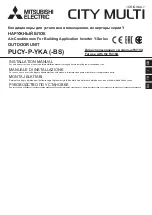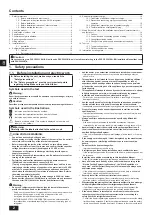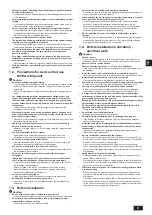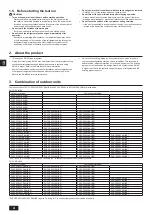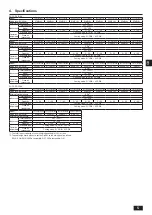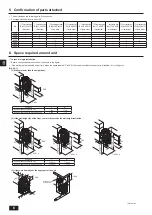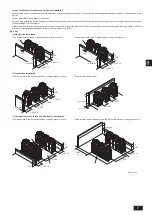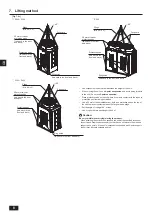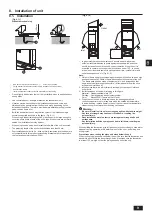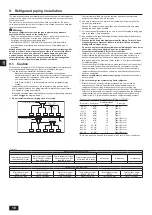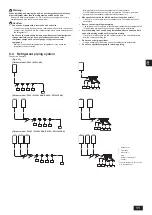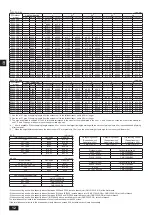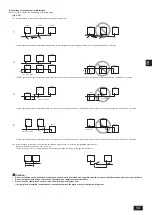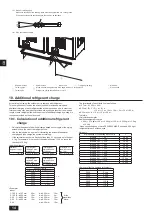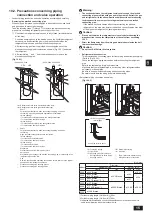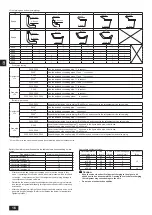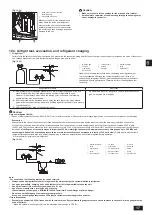
2
GB
1.1. Before installation and electric work
u
Before installing the unit, make sure you read all the
“Safety precautions”.
u
The “Safety precautions” provide very important points
regarding safety. Make sure you follow them.
Symbols used in the text
Warning:
Describes precautions that should be observed to prevent danger of injury
or death to the user.
Caution:
Describes precautions that should be observed to prevent damage to the unit.
Symbols used in the illustrations
: Indicates an action that must be avoided.
: Indicates that important instructions must be followed.
: Indicates a part which must be grounded.
: Beware of electric shock. (This symbol is displayed on the main unit
label.) <Color: yellow>
Warning:
Carefully read the labels attached to the outdoor unit.
HIGH VOLTAGE WARNING:
• Control box houses high-voltage parts.
• When opening or closing the front panel of the control box, do not let it
come into contact with any of the internal components.
• Before inspecting the inside of the control box, turn off the power,
keep the unit off for at least 10 minutes, and confirm that the capacitor
voltage (inverter main circuit) has dropped to 20 VDC or less.
(It takes about 10 minutes to discharge electricity after the power
supply is turned off.)
• Control box houses high temperature parts. Be well careful even after
turning off the power source.
• Perform the service after disconnecting the fan board connector
(CNINV) and the inverter board connector (CN1).
(To plug or unplug connectors, check that the outdoor unit fan is not
rotating and that the voltage of capacitor in the main circuit is 20 VDC
or below. The capacitor may collect a charge and cause an electric
shock when the outdoor unit fan rotates in windy conditions. Refer to
the wiring nameplate for details.)
• To connect wiring to TB7, check that the voltage is 20 VDC or below.
• Reconnect the connector (CNINV) back to the fan board and reconnect
the connector (CN1) back to the inverter board after servicing.
Warning:
• Do not use refrigerant other than the type indicated in the manuals
provided with the unit and on the nameplate.
- Doing so may cause the unit or pipes to burst, or result in explosion or fire
during use, during repair, or at the time of disposal of the unit.
- It may also be in violation of applicable laws.
- MITSUBISHI ELECTRIC CORPORATION cannot be held responsible
for malfunctions or accidents resulting from the use of the wrong type of
refrigerant.
• Ask the dealer or an authorized technician to install the air conditioner.
- Improper installation by the user may result in water leakage, electric
shock, or fire.
• This appliance is not intended for use by persons (including children)
with reduced physical, sensory or mental capabilities, or lack of
experience and knowledge, unless they have been given supervision
or instruction concerning use of the appliance by a person responsible
for their safety.
• This appliance is intended to be used by expert or trained users in shops,
in light industry and on farms, or for commercial use by lay persons.
• Install the unit at a place that can withstand its weight.
- Failure to do so may cause the unit to fall down, resulting in injuries and
damage to the unit.
• Use the specified cables for wiring. Make the connections securely so
that the outside force of the cable is not applied to the terminals.
- Inadequate connection and fastening may generate heat and cause a fire.
• Prepare for strong winds and earthquakes and install the unit at the
specified place.
- Improper installation may cause the unit to topple and result in injury and
damage to the unit.
• Always use filters and other accessories specified by Mitsubishi
Electric.
- Ask an authorized technician to install the accessories. Improper
installation by the user may result in water leakage, electric shock, or fire.
• Never attempt to repair the unit without the proper qualifications. If
the air conditioner must be repaired consult the dealer, contractor or
qualified Refrigeration Engineer.
- If the unit is repaired improperly, water leakage, electric shock, or fire may
result.
• If the supply cord is damaged, it must be replaced by the manufacturer,
its service agent or similarly qualified persons in order to avoid a
hazard.
• Do not touch the heat exchanger fins.
- Improper handling may result in injury.
• If refrigerant gas leaks during installation work, ventilate the room.
- If the refrigerant gas comes into contact with a flame, poisonous gases will
be released.
• Install the air conditioner according to this Installation Manual.
- If the unit is installed improperly, water leakage, electric shock, or fire may result.
• Have all electric work done by a licensed electrician according to the
“Electric Facility Engineering Standard”, the “Wire Regulations in
each area” and the instructions given in this manual and always use a
dedicated power supply.
- If the power source capacity is inadequate or electric work is performed
improperly, electric shock and fire may result.
• Securely install the outdoor unit terminal cover (panel).
- If the terminal cover (panel) is not installed properly, dust or water may
enter the outdoor unit and fire or electric shock may result.
• When installing and moving the air conditioner to another site, do not charge
it with a refrigerant different from the refrigerant specified on the unit.
- If a different refrigerant or air is mixed with the original refrigerant, the
refrigerant cycle may malfunction and the unit may be damaged.
• If the air conditioner is installed in a small room, measures must be
taken to prevent the refrigerant concentration from exceeding the
safety limit if the refrigerant should leak.
- Consult the dealer regarding the appropriate measures to prevent the safety
limit from being exceeded. Should the refrigerant leak and cause the safety
limit to be exceeded, hazards due to lack of oxygen in the room could result.
1. Safety precautions
Contents
1. Safety precautions ....................................................................................... 2
1.1. Before installation and electric work ............................................ 2
1.2. Precautions for devices that use R410A refrigerant .................... 3
1.3. Before installation ........................................................................ 3
1.4. Before installation (relocation) - electrical work ........................... 3
1.5. Before starting the test run .......................................................... 4
2. About the product ......................................................................................... 4
3. Combination of outdoor units ....................................................................... 4
4. Specifications
............................................................................................... 5
5. Confirmation of parts attached
..................................................................... 6
6. Space required around unit .......................................................................... 6
7. Lifting method .............................................................................................. 8
8. Installation of unit ......................................................................................... 9
8.1. Installation ................................................................................... 9
9. Refrigerant piping installation ..................................................................... 10
9.1. Caution ...................................................................................... 10
9.2. Refrigerant piping system .........................................................11
10. Additional refrigerant charge ...................................................................... 14
10.1. Calculation of additional refrigerant charge ............................... 14
10.2. Precautions concerning piping connection and valve
operation ................................................................................... 15
10.3. Airtight test, evacuation, and refrigerant charging ..................... 17
10.4. Thermal insulation of refrigerant piping ..................................... 18
11. Wiring (For details, refer to the installation manual of each indoor/outdoor unit
and controller.) ...................................................................................................... 19
11.1. Caution ...................................................................................... 19
11.2. Control box and connecting position of wiring ........................... 19
11.3. Wiring transmission cables ....................................................... 21
11.4. Wiring of main power supply and equipment capacity .............. 23
12. Test run ...................................................................................................... 25
12.1. Typical unit operation ................................................................ 25
12.2. Outdoor unit function setting ..................................................... 25
13. Information on rating plate ......................................................................... 26
Caution:
When connecting two PUCY-P250YKA(-BS) units and a PEV-P500YM-A unit, install them referring to the PUCY-P250YKA(-BS) Installation Manual that came
with PEV-P500YM-A.

